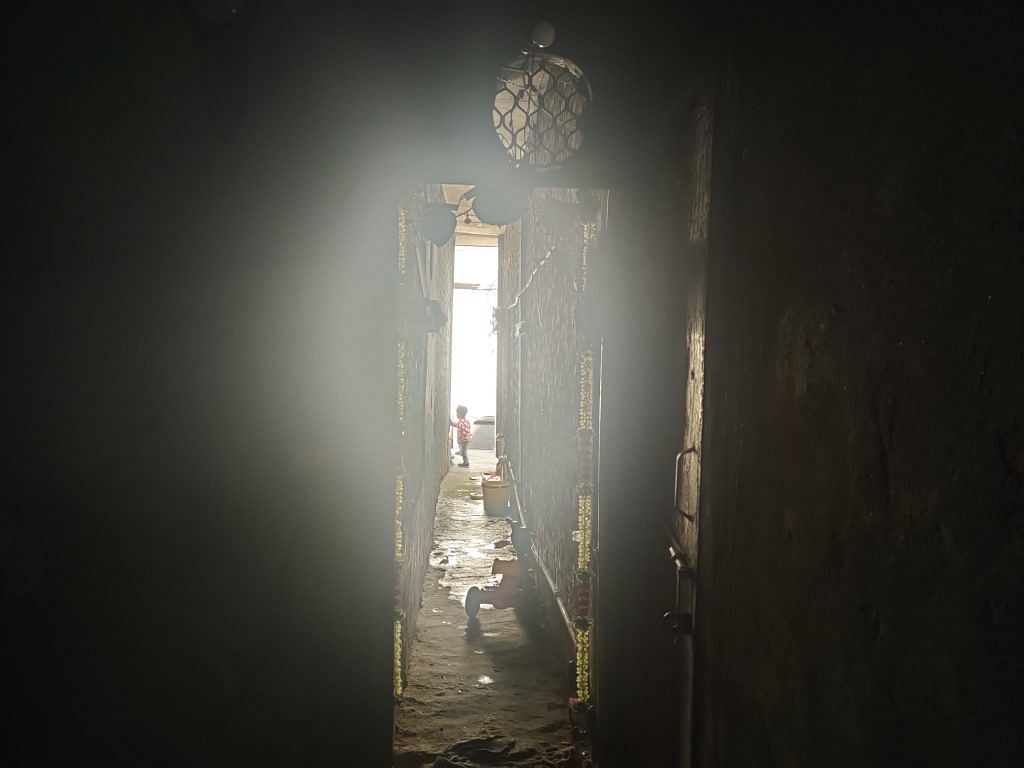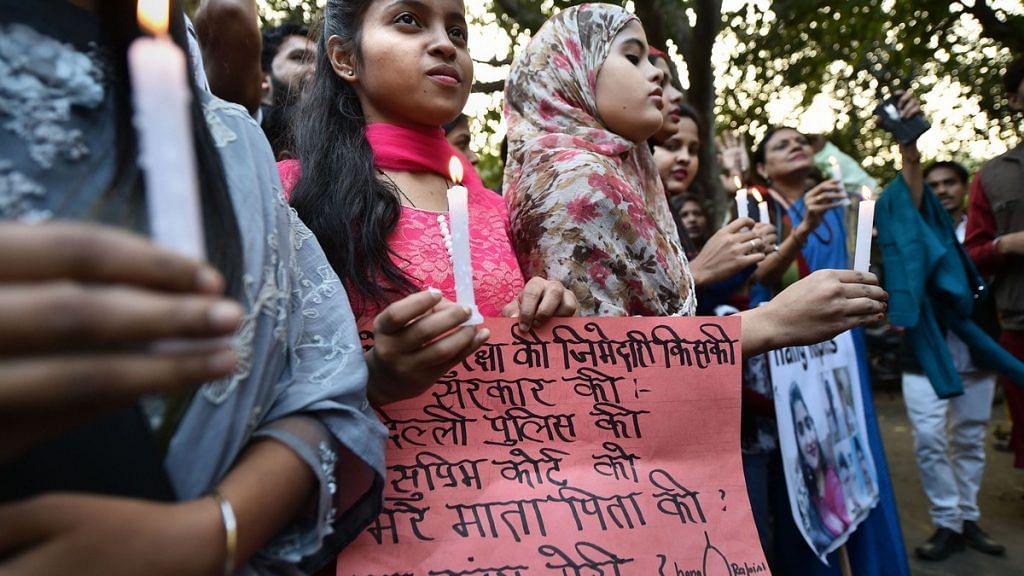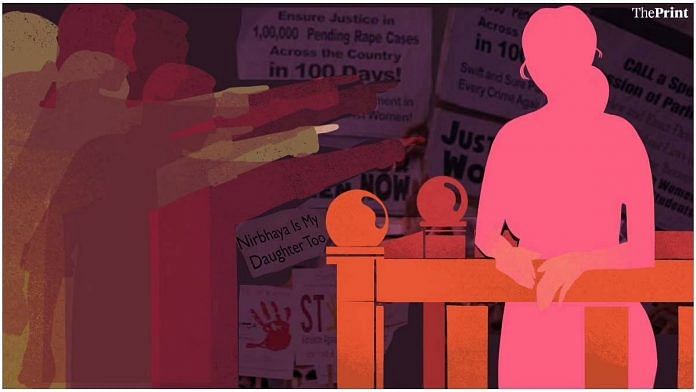New Delhi: Even a decade later, the details are hard to forget. A young woman and her friend watching Life of Pi on 16 December, 2012, at a movie hall in south Delhi, their search for transport home on a cold night, the white bus that finally stopped for them, and then the horror as six men on board brutalised and gangraped the woman, beat her friend, and threw them bleeding on the road.
The woman died a few days later, but it seemed as if India awoke. There were protests, marches, candlelight vigils, and relentless media coverage asking all the hard questions. Why did the police waste time arguing about jurisdiction while the woman lay dying? Should there be more stringent rape laws? What kind of society would breed this kind of violence towards women?
Then, fed by public outrage and anger, real changes seemed to take place over the next few years — zero FIRs allowed victims to lodge a complaint at any police station, the rape laws were made harsher, four of the rapists were hanged by the state in 2020 (one died by an apparent suicide, and another was a juvenile). The issue of rape had finally taken centrestage.
As for the victim — assigned the name Nirbhaya (Fearless One) by the media — she became a heroine in death, an emblem of India’s new fight against sexual violence.
Yet, 10 years down the line, victims of sexual violence still often suffer the greatest punishment — from society, from law enforcement, from the judiciary, and even occasionally from the media, which does not always treat victims with sensitivity.
Take for instance, the story of a 20-year-old mother from Delhi’s Shahdara. On Republic Day this year, while people watched parades on TV, she was sexually assaulted by a group of men and women and then marched down the streets with her hair tonsured and face blackened.
No one came to her rescue. Instead, onlookers hooted and took videos of her humiliation. By the time the police reached the spot, she had been badly beaten.

The wounds still haven’t healed. “I can’t sleep for more than an hour. I wake up at night, sweating, unable to fall back to sleep. I am scared to go outside to hang the washed clothes. I feel incapable of even the smallest of chores now,” she said.
What also haunts her is that the ordeal could have been prevented. Just days before the gruesome assault, her sister had tried to register a complaint with the police about constant harassment from a group of people who blamed the woman for a teenage boy’s suicide. He had apparently claimed to be in love with her. The police did not file a first information report (FIR) that day.
The Shahdara case is just one example of how, though the 16 December 2012 gangrape case led to changes in police procedures and law, ground realities have been harder to alter. The challenges include registering complaints, to getting convictions, to social stigma for rape victims.
Also read: ‘If a girl is alone, she’s not so believable’: Bihar’s mahila thanas are no place for women
‘Had the police taken action on time…’
As protests raged over the 2012 Delhi gangrape, the government appointed a committee to recommend amendments to the criminal law in sexual violence cases. Headed by Justice J.S Verma, the committee submitted its report in January 2013.
Broadly, its recommendations included expanding the definition of sexual assault, increasing the punishment for rape, discontinuing the intrusive ‘two-finger test’ for rape, and instituting measures to make it easier and quicker to file a police complaint. The Justice Verma committee’s suggestions were incorporated into the Criminal Law (Amendment) Act of 2013.
However, implementation has been patchy.
One high-profile example is the 2019 gangrape and murder of a veterinarian in Hyderabad. The night before her body was found, her sister approached the RGI Airport police station to register a complaint. However, instead of filing a zero FIR, as outlined in the Justice Verma report, the police allegedly delayed action citing lack of jurisdiction.
The police also reportedly asked whether the missing vet had a boyfriend, insinuating she might have taken off somewhere with him. The victim’s sister sought the police’s help at 11.30 pm, but an FIR was lodged only after 3 am at Cyberabad’s Shamshad police station.

When the rape and murder came to light, this case caused a huge furor. “Justice”, though, was swift when all four suspected rapists were shot dead by the local police in what they called an “encounter”, cheered on by sections of the media.
A Supreme Court panel probing the claimed encounter, however, saw it as an extra-judicial killing and in May this year recommended that the 10 policemen should be tried for murder.
In the Shahdara case, too, there have been accusations of police laxity.
On 19 January, the week before the assault, the victim’s 18-year-old sister had approached the police about a sustained campaign of harassment, including rape threats, by the family of a male acquaintance from their neighbourhood. As mentioned earlier, this group of people held the victim and her family responsible for the boy’s suicide.
“I was attacked and beaten up on 19 January. They burnt down our auto rickshaw (owned by the family). They came to the shop where I worked and harassed me. They threaten to rape me and when I step out, they hit me. They say that they aren’t scared of the police,” said the complaint. ThePrint has a copy of the complaint.
The victim and her family claimed that no FIR was filed and the police asked them to solve their “internal matter” among themselves.
After the 26 January assault, when ThePrint had asked the Shahdara deputy commissioner of police (DCP) R. Sathiyasudaram about the FIR not being filed earlier, he said the police were “looking into it”. An FIR was filed after the Republic Day assault, however.
“Had the police taken action on time, my wife wouldn’t have had to undergo this trauma,” the victim’s husband told ThePrint. She has had some counselling, but we don’t have the money for expensive therapy.”
The victim said she can barely even take care of her toddler and lives in constant fear. The slightest knock at the door, the sound of the wind against the window panes, the creaking sound of the bed — everything alarms her.
When her husband goes to work every morning, dropping their three-year-old son at school, he makes sure she bolts the door properly. “I leave for work only after I hear the sound of the bolt twice.”
Twenty-one people were apprehended in the case, including four men, 12 women, two girls, and three boys.
The women allegedly instigated the minor males “to push their private parts” in the victim’s mouth along with other forced sexual acts, police said. They also shaved her hair, blackened her face, and garlanded her with shoes before parading her down the road.
The Delhi Police has filed a 762-page chargesheet in the matter, which details that the victim and her family had been harassed for at least two months. The forensic reports have been submitted in court. ThePrint has a copy of the chargesheet.
Meanwhile, in other cases, the police have not just been accused of neglecting their duties but of actively working against rape survivors and their family members.
“It is love,” one Uttar Pradesh police officer reportedly said this August, as he allegedly sexually assaulted a rape survivor’s mother, who had visited him to ask about progress in the investigation in her daughter’s case.
In the rape and murder of a 13-year-old in Assam, a senior police official was accused of taking a Rs 2 lakh bribe from relatives of accused to “dilute” the case”. Other police personnel and three doctors were also arrested for allegedly trying to tamper with evidence.
In September, a 26-year-old woman in Madhya Pradesh set herself on fire after the police allegedly refused to register her rape complaint against a government official.
Elusive ‘justice’
Much has been written about India’s low rate of conviction in sexual assault cases.
In the ‘Crime in India 2021’ report of the National Crime Records Bureau (NCRB), the conviction rate of rape cases stood at 28.6 per cent last year, which means that out of 100 accused, not even 30 received a conviction. The conviction rate for 2020 was slightly better, at 29.8 per cent.
“Since the December 2012 gangrape case, there have been an increase in the number of reported rape cases to an extent, but the conviction rate remains abysmal,” said Kalpana Viswanath, CEO and co-founder of the women’s safety app, Safetipin.
Lack of proof is often cited as a reason for the low conviction rate — or for convictions being overturned by higher courts. This is at least partly due to shortfalls and delays in gathering and processing forensic evidence.
A dramatic example of this is the Chhawla rape-murder case.
In February 2012, months before the Nirbhaya case hit the headlines, another young woman met a horrific death. While the 19-year-old was returning from her workplace at Gurgaon’s swanky Cyber Hub, three men in a red Tata Indica allegedly pulled her into their car in Dwarka’s Chhawla area.
A few days later, the police arrested three suspects, who led them to her body at a Haryana village. She had allegedly been gangraped before her death, and as the postmortem report showed, brutalised with liquor bottles and metal objects.
Just over 10 years later, in November 2022, the Supreme Court acquitted the three accused, who had earlier been sentenced to death by a lower court.
The SC observed that while DNA samples from the accused and victim were collected on 14 and 16 February of 2012 respectively, they were only sent to the Central Forensic Science Laboratory (CFSL) on 27 February.
The court noted that in the intervening period, the samples were kept in the evidence room of the police station, which opened up the possibility of tampering with evidence.
This, among other procedural lapses, was enough for the court to give the “benefit of the doubt” to the three men, described earlier as “sexual psychopaths” by the Delhi High Court.
Even now, delayed forensics continue to hinder the justice system for rape victims and even those accused.
In 2016, for example, a Delhi court pulled up the police over absence of forensic report in a JNU rape case despite repeated reminders. A standing order was passed in 2015 on steps for expediting forensic reports for a speedy trial.
Trial by society
That justice is slow, if it comes at all, is something that most rape victims know first-hand. At the same time, many feel they are under trial by society right from the time they report the crime.
The Shahdara victim told ThePrint that justice seems like a dream, even as she must live with the “shame” of the assault.
“The trial will continue for years and years,” she said. “Now my son is young, what will happen when he grows up? I want to work, who will give me a job?” she said.
She added: “The videos of my assault went viral, even if my face was blackened, people still recognise me. I sometimes fear what if my husband leaves me one day because of this. Most relatives and neighbours think I had an affair with that boy.”
Carrying on with normal life has also been next to impossible for the victims of what is referred to as the Bulandshahr highway gangrape case.
On 29 July, 2016, a Noida family was on their way to a village in UP’s Shahjahanpur to attend a funeral. At about 1 am, their vehicles were intercepted in Bulandshahr by a gang. They looted the family of cash and valuables and allegedly dragged the mother and her teenage daughter to a jungle and raped them.
After various snarls in the probe by the state police, the case was transferred to the Central Burau of Investigation (CBI), which filed its first chargesheet in November 2016, and a supplementary one later.
Five years from then, the trial is only now in the evidence presentation stage, said police sources and the victims’ lawyer. The main accused has died, reportedly of a kidney ailment, while two others are lodged in jail. Three other accused are out on bail since the prosecution could not present enough evidence against them, they added.
The victim’s lawyer Kisley Pandey blamed the delay on Covid-19 lockdown and on the strikes in trial courts.
“This is not only dangerous for the redressal of justice, but also blatant violation of fundamental rights of the citizens,” Pandey said.
Over this period of time, the victims and their family have also suffered torment.
They were hounded by the media, and also found themselves at the centre of a controversy after Samajwadi Party leader Azam Khan described the gangrape as a “political conspiracy”.
The spotlight, speculation, and social isolation forced the family to move out of their home in Noida’s Khoda.
“We moved out because everyone from journalists to politicians made a tamasha (spectacle) out of us. The eyes of questioning neighbours didn’t let us breathe. We couldn’t live like that,” the mother said.
“The trial has been going on, we don’t know much. We do go to court for hearings, but a lot of it is just beyond our understanding,” her husband said.
The teenage victim, her mother said, is now 19. “She is trying to have a normal life, but the trauma from the past keeps coming back. We just want all of this to get over soon.”
‘The ideal victim’
The phenomenon of victim-blaming, including in news media, has been well-documented in academic research. One aspect of this is that some victims are presented as vulnerable and blameless, while others are portrayed as somehow responsible for what happened to them.
This is a serious issue since such portrayals of victims influence public perceptions and may make victims less likely to seek help or file a complaint.
Even the courts at times are, unfortunately, not above victim-blaming.
In June 2020, for example, a Karnataka High Court judge noted that it was “unbecoming of an Indian woman to sleep after she is ravished… That is not the way our women react when they are ravished.” He made this observation while granting anticipatory bail to a rape accused.
Then, earlier this year, a judge in a Kerala sessions court observed that and accusation of sexual harassment would not prima facie stand when the complainant was “wearing a dress that was sexually provocative”. The judge said this while granting bail to an accused. The Kerala High Court later upheld the bail order, but the remarks were expunged.
In September 2017, the Punjab and Haryana High Court granted bail to three students who had earlier been convicted and sentenced by a trial court for the gangrape of a collegemate.
“The accused are young and there was no gut-wrenching violence which normally accompanies such situations,” the HC’s order said.
“It would be a travesty if these young minds are confined to jail for an inordinate long period which would deprive them of their education, opportunity to redeem themselves and be a part of the society as normal beings,” the order had further noted.
The judges also made references to “promiscuity”, “adventurism”, and “experimentation in sexual encounters” in relation to the complainant.
“[A] careful examination of [the complainant’s] statement again offers an alternate conclusion of misadventure stemming from a promiscuous attitude and a voyeuristic mind,” the court said.
In the 2021 rape case of an IIT Guwahati student, the Gauhati High Court while granting bail to the accused noted that while there was a “clear prima facie case” against him, both he and the victim were “talented students” and the “state’s future assets”.
Viswanath pointed to the pervasiveness of “patriarchal” thinking across society and its systems.
“We have a long way to go. There is still an ingrained regressive attitude towards women — victim shaming, questioning. This is not there just for rape, but for all forms of violence against women,” she said.
Viswanath observed that this was also evident in reactions to the murder of Shraddha Walkar, allegedly at the hands of her live-in boyfriend.
“Many on social media questioned her choices and basically blamed her for it in a way. Even though there has been some change in the social attitude towards victims of sexual violence, at another level there is also backlash which shames women who raise their voice against their perpetrators.”
(Edited by Asavari Singh)
Also read: Bihar panchayat’s punishment for man who ‘raped 5-yr-old’: 5 sit-ups. FIR filed after viral video



